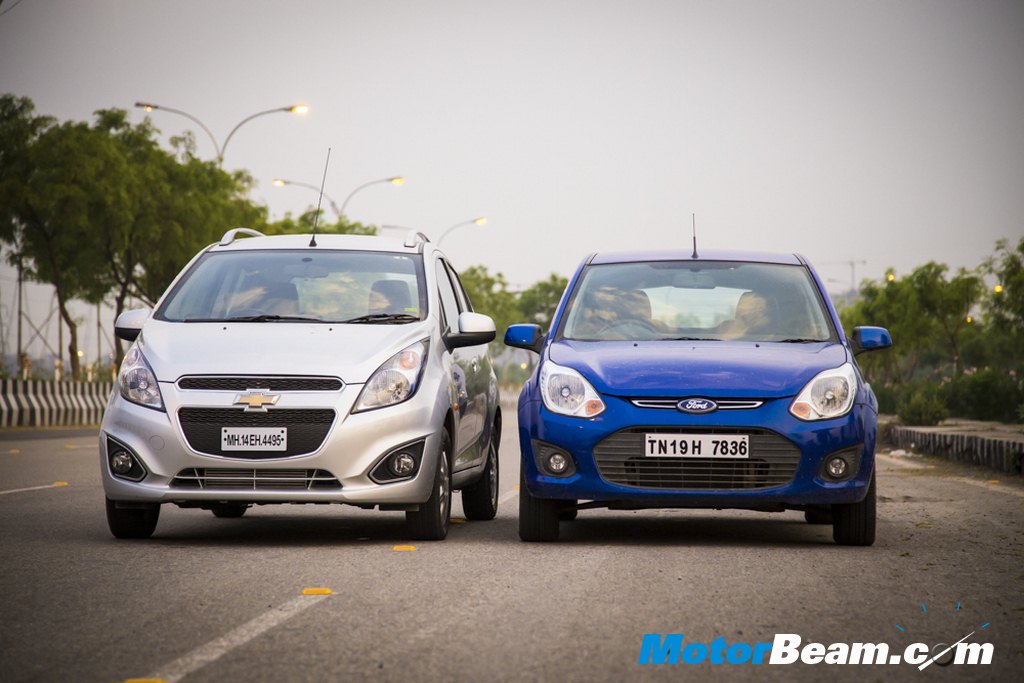Text – Aariz Rizvi; Pictures – Nitin Gupta

Shootout – Chevrolet Beat vs Ford Figo
Price OTR Mumbai: Rs. 4.78 – 7.22 lakhs (Chevrolet Beat), Rs. 4.72 – 7.52 lakhs (Ford Figo)
The two American brands offer distinctive hatchbacks that belong to the same segment
Many of us are aware that hatchbacks contribute to almost half of Indian car sales and hence you see several comparos between all sorts of hatchbacks at MotorBeam. Just recently we did a shootout between the most fun to drive hatchbacks in India. We did a mega hatchback war between five cars a while back and also set premium offerings – Mercedes A-Class and BMW 1-Series side by side. This time around, we juxtapose the two famous American brand offerings – the Chevrolet Beat and Ford Figo. We observe the entry level diesel hatchbacks keenly to perceive their potential. Both the offerings were released with mild updates at the 2014 Auto Expo.
Motor Quest: The Ford Figo is in its first generation since 2010 while the Chevrolet Beat is currently being offered in its third generation. The Ford Figo got its mid-cycle facelift within two years of its launch while the Chevrolet Beat took five years for a mild update.

Styling – These two cars have been around on our roads since 4-5 years and we are quite familiar with their design. They are fairly distinctive in terms of styling. The Ford Figo got its mid-life facelift in 2012 that gets quite substantial changes compared to the Chevrolet Beat facelift, which was launched recently at the 2014 Auto Expo. The Figo got new headlamps, tail lamps and fresh bumpers while the Chevrolet Beat gets mild revisions of headlamps, tail lamps and bumpers. The Chevrolet Beat has a youthful design language to boast that makes it look funky. The Ford Figo on the other hand has a neutral and safe styling.

The Chevrolet Beat is easily the more stylish of the two, some snazzy styling cues include dual port grille, angular headlamps and clean two-door like side profile thanks to the unconventional rear door handles. However it is smaller than the Figo and looks compact when you see both of them together in flesh. The Ford Figo is treated with simple lines and creases but it has some sporty cues like the front wide grille, alloy pattern and vertical tail lamps. Otherwise it starts looking old once compared to the Chevrolet Beat.
The Chevrolet Beat has the best interior design and quality but it’s the Ford Figo which is more convenient
Interiors – Both the cars have a dark interior theme with silver inserts but the Chevrolet Beat gets an all black dashboard while the Ford Figo uses dark blue shade on its dashboard. In terms of interior styling and quality, the Chevrolet Beat is the more appealing hatchback because of the smooth flowing dashboard and the sci-fi instrument cluster with a sporty steering wheel. The Ford Figo dashboard looks rather cluttered and isn’t relatively easy on the eyes. There is a protruding airbag panel, centre console looks quite aftermarket and bright orange instrument cluster doesn’t really gel with the overall theme. The Ford Figo interior quality doesn’t feel premium but it definitely feels rock solid and built to last.
The Beat gets tastefully done interiors but the Figo is more practical and better equipped
Regardless of how good the styling is on the Chevrolet Beat, you miss out quite a lot of features and equipment and on that front the Chevy is quite basic unlike the Figo. You only get radio, CD, USB and AUX connectivity in the Beat and there is no Bluetooth. You get steering mounted controls now but it doesn’t have channel up/down buttons on them. The ORVMs are not electrically adjustable and there is no keyless entry system, not even a button on the driver side to lock/unlock all doors, you have to pull and push a tiny door lever. The instrument cluster doesn’t show distance to empty and fuel efficiency.
The aforementioned missing features are present in the Ford Figo and additionally, the Bluetooth system streams music as well as the phonebook from your smartphone and now you get a WiFi dongle too with the 2014 update. Howbeit, no rear power windows even in the range topping Figo is disappointing. The Ford Figo is more comfortable and practical because the seats are supportive, stowage space is adequate and the boot is substantially more spacious than the Chevrolet Beat. The Beat has poor under-thigh support and headroom at the rear. It comes with a tiny boot of 170 litres while the Figo boasts of 280 litres of massive luggage capacity.
Performance – Both the cars come with petrol and diesel engine options, while General Motors also offers the option of an LPG kit with the petrol Beat. Both the Chevrolet Beat and Ford Figo get a 1.2-litre petrol engine producing 80 PS of power with 108 Nm of torque and 71 PS of power with 102 Nm of torque respectively. The Beat’s motor is better as it returns decent mileage although neither of the petrol cars offer good performance to set your pulse racing. The pick of the bunch though are the diesel engines and here the story is different between the two hatchbacks. The Chevrolet Beat currently has the smallest diesel engine in India, which is a 3-cylinder, 1.0-litre unit that produces 58.5 PS of power and 150 Nm of torque. This is the same 4-cylinder, 1.3-litre MultiJet diesel unit widely used in India but it has got rid of one cylinder carrying 312cc for better efficiency. The Ford Figo gets a bigger 1.4-litre, 4-cylinder DuraTorq diesel engine producing 69 PS of power and 160 Nm of torque.
The Beat’s tiny oil burner is more suited for city driving while the Figo has the punch for highways
The Chevrolet Beat is quicker off the line because of its nonexistent turbolag, while the Ford Figo has to go through 1800 RPM to pick good pace. Now that the Figo is in its turbo band, it pulls strongly in the mid-range with a decent power holding top-range for confident highway drivability. The Beat on the other hand is linear in the mid-range with power sharply falling near the redline, which shows its city oriented nature. In terms of NVH, the Figo betters the Beat because the cabin is well insulated and only gets noisy at high RPMs. The Beat’s 3-cylinder vibrations are evident and diesel clatter is always there. Both are mated to a 5-speed manual gearbox, which is notchy in the Beat but smoother in the Figo. The Beat is relatively short geared while the Figo gets spaced out ratios for mixed city and highway drivability. The Chevrolet Beat returns a claimed efficiency of 25.44 km/l while the Figo returns 20 km/l. The Figo’s DuraTorq definitely feels more powerful and enjoyable with a meaty wave of torque. While the Beat feels underpowered on the highways, the Figo feels less so, making the Ford mill the better engine of the two.
Driving Dynamics – The Ford Figo has been appreciated for its sorted driving dynamics thanks to the well balanced chassis but the Chevrolet Beat is impressive too in its own way. Unlike its petrol variant, the Beat diesel gets electronic power steering which is light, responsive and quite fun within city limits. The Beat handles the gaps and corners of the city quite sprightly but show it some long straights with fast corners then it starts feeling nervous because the steering lacks feedback at high speeds and remains light. The Figo’s hydraulic unit is amazing and the confidence it provides at high speeds is remarkable. It is a tad heavy at parking speeds but quite adaptive after gaining pace. You can literally throw it around corners at great speeds without a sweat and it responds sharply to your commands to the steering. Handling in the ghats is extremely fun.
The suspension setup of the Beat is again city oriented that offers pliant ride over most of the surfaces but tends to bounce at high speeds. The Figo feels little stiff at slow speeds but boy it is such a mature suspension that it feels as solid as a tank at high speeds with great confidence. It takes all the bumps and potholes in its stride orderly and hardly gives up on the crudest of roads. So the Ford Figo simply trumps the Beat when it comes to ride and handling balance. It puts a smile on your face when you are attacking corners while maintaining good speeds and getting out of the bends in a crisp line with minimal body roll unlike the Beat. Both the cars are good enough on the braking front but the pedal feedback could be better on the Figo.
Safety – Both the hatchbacks get four star NCAP safety ratings globally. However, the India-spec Chevrolet Beat hasn’t been tested yet, as it was the Euro-spec version with more safety features that got the four star rating. Recently the India-spec Ford Figo was tested by Global NCAP amongst other Indian hatchbacks and got a healthy four star rating. The Beat gets ABS and airbags as optional safety kit only on the range topping trim, while the Figo gets ABS and dual airbags as standard on the Titanium trim and driver side airbag on the ZXi trim. So the Ford Figo is safer and also structurally sturdy.
Verdict – Choosing between the two is quite an easy job and depends on your needs. The Ford Figo is a mature car with a bigger diesel engine and confident highway drivability. With a bigger boot, additional convenient and safety features, the Figo is meant for those who spend most of the time in their car. The Chevrolet Beat on the other hand is a city oriented car with good low-end performance, light controls and basic utility features. So if your running is limited to the city then opt for the Beat otherwise get the Figo. However, if we see from an overall perspective, the Ford Figo wins this shootout because it offers more at a similar or even lower price in some variants and is definitely more fun to drive while also being safer.
The verdict is simple, if you spend more time behind the wheel and hit the highways frequently then get the Ford Figo otherwise the Chevrolet Beat is a convenient compact city car with a frugal little diesel engine. However, you get some extra goodies on the Figo and it is significantly more fun than the Beat.
Further Reading –
2014 Chevrolet Beat Review
Ford Figo Review




